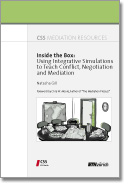This is the first in a Lessons Learned series on essential resources for simulation development.
Natasha Gill’s e-book, Inside the Box: Using Integrative Simulations to Teach Conflict, Negotiations and Mediation, is (in my admittedly humble opinion) very nearly a one-stop shop for educational simulation development. While Gill designs simulations specifically to teach peacebuilding negotiation skills, her method and accompanying manual can be applied to the development of simulations of other political, social, and economic scenarios as well. I have explicitly adapted Gill’s “IN-Simulation” method in the design of LLST’s upcoming sim, The Day My Life Froze: Urban Refugees in the Humanitarian System.
Gill does an excellent job of standing up for simulations as educational tools, even in the most rigorous academic contexts. Simulations, she claims, “provide participants with the opportunity to immerse themselves directly in a conflict… to learn about the beliefs and interests of a wide variety of actors from their own perspectives, and experience the dynamics between parties in an environment that closely replicates reality” (p 14).
She contrasts simulations with more traditional methods of educational delivery, like lectures, and argues (successfully, in my point of view) that criticisms of simulations as educational tools should more accurately be targeted at specific instances of poor simulation design. Every student knows that lectures can be spellbinding or painful to sit through; in the same way, an educational sim can be robustly built around specific learning goals, or be nothing more than a vapid set of loose instructions, with little to no oversight of the learning process.
Responsible designers of educational simulations, clearly, must begin the process of simulation development with a definition of what lessons should be learned via the experience. A good simulation should ideally be set into a curriculum which frames and gives context for the lessons learned in the activity—and, of course, requires a structured debriefing session where disparate experiences can be collected, reviewed, and reflected upon both in a group and individual setting.
Gill makes the interesting assertion that simulations should at first force participants to think “inside the box,” a point which she considers sufficiently integral to make the title of the publication. In her view, too many simulations which immediately encourage participants to engage in “out of the box” thinking produce idealistic but unrealistic strategies. Such strategies may sound exciting on the surface, but in practice fail to accommodate the real-life restrictions which act on stakeholders: there typically are reasons why these supposedly innovative approaches have not played out in practice.
Instead, by first exploring “inside the box”—ie, first attempting to trace existing strategies with attention to a particular point of view—participants learn the dynamics which have prevented similar idealistic but unrealistic solutions from taking root in reality. Gill suggests that, by the end of a well-designed and facilitated simulation, participants are typically ready to be let “out of the box” to make attempts at more creative approaches to solving humanity’s long-standing problems—attempts which still typically do not result in success, she admits, but at least at this point participants will have learned enough to understand why their initiatives fail to satisfy all stakeholders.
My only point of contention—which I share with Prof. Rex Brynen of PAXsims—is her claim that well-designed simulations could only refer to non-fictional “real life” scenarios. This claim may be tied to her specific interest in political negotiations; however, in the context of humanitarian response modeling, it is certainly possible (and perhaps even preferable) to build robust but fictional environments from research on a conglomerate of various non-fictional scenarios. I would counter that, in humanitarian contexts (and other contexts which feature gross differentials in dynamics of power), it is often much more respectful to vulnerable groups being included in the simulation if their roles are fictionalized or somehow abstracted. While facilitating a respectful role-filling of any refugee experience is an ethical challenge, asking a humanitarian to “role-play” as a Syrian or Iraqi refugee could easily result in an unproductive ethical transgression.
In summary, it is exciting to see such a complete, well-researched, and clearly communicated publication on simulation-based teaching–and given that it’s free, there is no excuse to skip out on Natasha Gill’s Inside the Box.
Download Inside the Box directly from ETH Zurich: http://www.css.ethz.ch/en/publications/mediation-reports/mediation-resources/details.html?id=/i/n/s/i/inside_the_box_using_integrative_simulat

